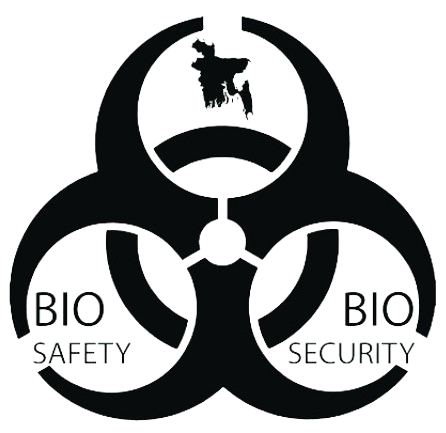Principles of Biological Risk...
Principles of Biological Risk....
Course Discription
Dr Asadulghani
[MSc, MPhil, PhD]
Head, Biosafety and BSL3 Laboratory, icddr,b &
President, Bangladesh Biosafety and biosecurity Society
Objectives
• Principles of Biological Risk Assessment
• Biosafety and Biosecurity Perspective
• Current Status of icddr,b
Objectives
• Principles of Biological Risk
Assessment
• Biosafety and Biosecurity perspective
• Current Status of icddr,b
Risk Assessment
Is a process that involves hazard identification and hazard control.
US Airways Magazine, October 1991
Risk Perception Risk Assessment Risk Management
Biorisk Assessment
Agent 3
Agent 1
Likelihood
Consequence
Technique1
Technique 3
Technique 2
Likelihood
Consequence
Agent 2
Biorisk Assessment
The emergent science based on toxicology, epidemiology and
statistics that utilizes qualitative and quantitative biohazard
analysis to provide the public with a reasonable estimate of
probability of harm.
Why Do We Need Biorisk
Assessments? ✓We work with or handle infectious
materials and/or cultures every day!
✓A large number of field workers are
collecting biological specimens and
environmental samples every day!
✓Patient specimens are collected at
the specimens reception area!
✓Sterilization facility is handling and
sterilizing large amount infectious
waste!
✓Satellite Waste Accumulation Area is
receiving infectious waste everyday
for incineration!
Why Do We Need Biorisk
Assessments? To prevent laboratory-
acquired infections (LAIs)
from
✓ Direct contact (spills/splashes) to
mucous membranes
✓ Inhalation of aerosols
✓ Ingestion
✓ Percutaneous inoculation from
cuts, sharps, vectors, non-intact
skin
✓ Indirect contact (contamination
from fomites)
Why Do We Need Biorisk
Assessments? ✓To reduce and minimize
the risk of exposure to
workers and the
environment.
✓But remember, Risk is
never zero!
• Are we working with
“Maximum Risk”???
World's safest airlines - the ones that
have never had a single plane crash!
Principles of Biorisk Assessment
• Identify the Agent
• Identify Activities or Specific Tasks
• Identify the Hazards – What can go wrong
• Identify the Current Controls
• Likelihood
• Consequence
• Estimate Risk
• Mitigate Hazards
• Risk Control Plan – specific control measures
• Annual Review
Risk Matrix
Actions required based on Risk
Matrix
Objectives
• Principles of Biological Risk Assessment
• Biosafety and Biosecurity Perspective
• Current Status of icddr,b
Biosafety and Biosecurity
Perspectives
To save the entire
biosphere from
unintentional release
biohazards
Biosafety
To secure the biohazard
from intentional
release for its
deleterious effect to
the biosphere
Biosecurity
Risk group (RG) of microorganisms
Microbes
RG1 Non pathogenic
RG2
Disease rarely serious
Food, water or blood borne
Treatment & prevention often available;
Moderate individual risk and low
community risk
RG3
Serious or lethal; Airborne
Treatment & prevention may be available;
High individual risk and low community
risk
RG4
Lethal; Known or unknown transmission
route; Treatment & prevention Not
usually available; High individual risk and
high community risk
Biosafety Risk
Biosafety Risk
Likelihood of unintentional
exposure
Likelihood of infection
based upon the intrinsic
properties of the biological
agent
Likelihood of infection
based upon laboratory
procedures and in-place
mitigation measures
Consequence of disease
Likelihood of unintentional exposure: Likelihood of infection
based upon the intrinsic properties of the agent (M. t.)
RISK GROUP:
HOST RANGE:
INFECTIOUS DOSE:
MODE OF TRANSMISSION:
INCUBATION PERIOD:
COMMUNICABILITY:
RESERVOIR:
ZOONOSIS:
VECTOR:
SURVIVAL OUTSIDE HOST:
DRUG RESISTANCE:
RG3
Monkeys, humans, cattle, sheep, goats, etc.
<10 bacilli
Airborne, percutaneous transmission, etc.
4-6 weeks
Highly communicable
Humans and diseased animals
YES
NONE
Survive for months, 8 weeks (cockroach feces)
MDR, XDR
Likelihood of unintentional exposure: Likelihood of exposure
based upon laboratory procedures and in-place mitigation
measures (M. t.)
CONTAINMENT:
PROTECTIVE CLOTHING:
PHYSICAL INACTIVATION:
TREATMENT:
DISINFECTANTS:
IMMUNIZATION:
PROPHYLAXIS:
BSL3/CL3/P3
Respirator, full protective clothing, eye
protection
121°C for at least 15 min (easily killed by heat)
YES
Chemical Disinfection
BCG
YES
Biosecurity Risk
Biosecurity Risk
Likelihood of intentional
exposure
Likelihood of infection
based upon the intrinsic
properties of the biological
agent
Likelihood of infection based
on security measures
according to Biosafety Levels
in place
Consequence of disease
Category A, B, and C Priority
•Pathogens Category A Priority Pathogens
• Can be easily disseminated or transmitted from person to person
• Result in high mortality rates and have the potential for major public health impact
• Might cause public panic and social disruption
• Require special action for public health preparedness
• Category B pathogens are the second highest priority
organisms/biological agents. They
• Are moderately easy to disseminate
• Result in moderate morbidity rates and low mortality rates
• Require specific enhancements for diagnostic capacity and enhanced disease surveillance
• Category C pathogens are the third highest priority and
include emerging pathogens that could be engineered for
mass dissemination in the future because of
• Availability
• Ease of production and dissemination
• Potential for high morbidity and mortality rates and major health impact
Category A, B, and C Priority
•Pathogens Category A
o Bacillus anthracis (anthrax)
o Clostridium botulinum toxin (botulism)
o Yersinia pestis (plague)
o Variola major (smallpox) and other related
pox viruses
o Francisella tularensis (tularemia)
o Viral hemorrhagic fevers
• Category B
o Burkholderia pseudomallei (melioidosis)
o Coxiella burnetii (Q fever)
o Brucella species (brucellosis)
o Burkholderia mallei (glanders)
o Chlamydia psittaci (Psittacosis)
o Ricin toxin (Ricinus communis)
o Epsilon toxin (Clostridium perfringens)
o Staphylococcus enterotoxin B (SEB)
o Typhus fever (Rickettsia prowazekii)
o Food- and waterborne pathogens
o Mosquito-borne viruses
• Category C
o Nipah and Hendra viruses
o Additional hantaviruses
o Tickborne hemorrhagic fever viruses
o Tickborne encephalitis complex flaviviruses
o Tuberculosis, including drug-resistant TB
o Influenza virus
o Other Rickettsias
o Rabies virus
o Prions
o Coccidioides spp.
o Severe acute respiratory syndrome associated
coronavirus (SARS-CoV), MERS-CoV, and other
highly pathogenic human coronaviruses
Select Agents and Toxins
A list of biological agents that have the potential to
pose a severe threat to animal health and safety,
plant health and safety, or to the safety of animal or
plant products. The agents are divided into-
(1) HHS select agents and toxins affecting humans;
(2) USDA select agents and toxins affecting agriculture;
and
(3) Overlap select agents and toxins affecting both.
22
HHS select agents and toxins
•affecting humans Bacteria
o Botulinum neurotoxin-producing
species of Clostridium*
o Coxiella burnetii
o Burkholderia mallei* (formerly
Pseudomonas mallei)
o Burkholderia pseudomallei* (formerly
Pseudomonas pseudomallei)
o Francisella tularensis*
o Rickettsia prowazekii
o Rickettsia rickettsii
o Yersinia pestis*
• Viruses
o Coronavirus
o Encephalitis viruses
o Influenza viruses
o Orthopoxviruses
o Viral hemorrhagic fever (VHF) viruses:
23
• Toxins
o Abrin
o Botulinum neurotoxins*
o Clostridium perfringens epsilon toxin
o Conotoxins
o Ricin
o Saxitoxin
o Shiga-like ribosome inactivating proteins
o Shiga toxin
o Staphylococcal enterotoxins
o Tetrodotoxin
o 2 Type A trichothecenes:
USDA select agents and toxins
affecting agriculture
• Bacteria
• Bacillus anthracis*
• Brucella abortus
• Brucella melitensis
• Brucella suis
• Burkholderia mallei* (formerly
Pseudomonas mallei)
• Burkholderia pseudomallei* (formerly
Pseudomonas pseudomallei)
• Viruses
• Hendra virus
• Nipah virus
• Rift Valley fever virus
• Venezuelan equine encephalitis
virus (excluding enzootic subtypes
ID and IE)
24
Overlap select agents and toxins
•affecting both Bacteria
o Mycoplasma capricolum
o Mycoplasma mycoides
• Viruses
o African horse sickness virus
o African swine fever virus
o Avian influenza virus
o Classical swine fever virus
o Foot-and-mouth disease virus
o Goat pox virus
o Lumpy skin disease virus
o Newcastle disease virus
o Peste des petits ruminants virus
o Rinderpest virus
o Sheep pox virus
o Swine vesicular disease virus
• Fungi or fungus-like pathogens
o Peronosclerospora philippinensis
(Peronosclerospora sacchari)
o Phoma glycinicola (formerly
Pyrenochaeta glycines)
o Sclerophthora rayssiae var zeae
o Synchytrium endobioticum
25
Likelihood of intentional exposure: Likelihood of infection
based upon the intrinsic properties of the biological agent (M.
t.):
CATEGORY:
DISSEMINATION:
TRANSMISSION:
EASE OF PRODUCTION:
MORBIDITY AND MORTALITY:
C
Can be disseminated aerosol
Human to human transmission
Can be produced easily
Potential for high morbidity and
mortality
Likelihood of intentional exposure: Likelihood of exposure
based on security measures according to Biosafety Levels in
place (M. t.)
Biosafety Level:
Physical Security:
Personal Security:
Material Control and
Accountability:
Information Security:
Transport Security:
3
Entry exit, access control, CCVT, Security Only
authorized individuals have the access
Complete inventory with assigned responsibility
Password protection, barcoding
Following SOP and IATA
Objectives
• Principles of Biological Risk Assessment
• Biosafety and Biosecurity perspective
• Current Status of icddr,b
Biological Risk Assessment for
Laboratories
• Specimens Reception (?)
• Laboratories (?)
• Animal Handling Facility (?)
• Biorepository (?)
• Waste Accumulation and Management (?)
Biorisk Management
Risk
Assessment
Need
Assessment
Facility Facility
Personal Personal
Practices Practices
Current Scope
Actual
Scope
Renovation
Upgradation
Rectification
Awareness
Training
Retraining
Manual
SOP
Forms
Baseline
Assessment
Best Practices in
Biorisk Management
Biological Risk Assessment for
▪Laboratories All the laboratory staff
members should
understand how to
conduct Biological Risk
Assessment focusing on
the individuals’ job
responsibility.
▪ PIs should complete this
Worksheet on Risk
Assessment for each
ongoing projects.
Strengthening the current status
• Reporting incidence
• Use of PPE
• Waste management
32
Acknowledgements
• Dr Hubert P Endtz, Professor of Tropical Bacteriology,
Department of Medical Microbiology & Infectious
Diseases, Erasmus MC
• Dr Barbara Johnson, Biosafety and Biosecurity
International
• Dr Natasha K. Griffith, Associate Director of Operations,
High Containment Core at Georgia State University
• Biosecurity Engagement Program (BEP) of The US
Department of State
• CDC, Atlanta, USA
Thank you

